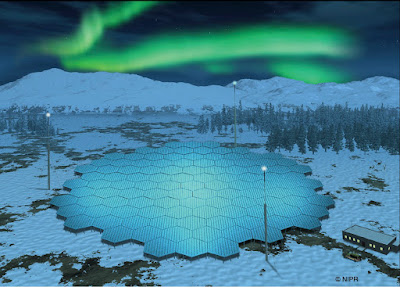 |
| Artist impression of the EISCAT_3D transmitter-receiver: there are 109 hexagonal antenna groups, each of which consists of 91 antennae. The diameter of the whole installation is about 70 metre. |
The EISCAT_3D facility will be distributed across three sites in Northern Scandinavia - in Skibotn, Norway, near Kiruna in Sweden, and near Kaaresuvanto in Finland. Each site will consist of about 10.000 antennas fed by a powerful 5 MW transmitter at Skibotn and a receiver at each of the three sites. The total budget is 70 M€ and the project will start in September 2017. Site preparations begin in summer 2018 and the radar is expected to be operational in 2021.
 |
| The EISCAT_3D radar consists of three sites: the transmitter-receiver in Norway and two receiver sites in Finland and Sweden. |
EISCAT_3D makes it possible to study how energetic particles and electrical currents from space affect the upper and the lower atmosphere as well as man-made technologies such as satellites and power grids on the ground. Also, the aurora borealis can be studied in three dimensions.
The system will be built by the EISCAT Scientific Association, comprising research councils and national institutes from Finland, Norway, Sweden, the United Kingdom, Japan and China. EISCAT_3D is the culmination of a 10-year design and preparation phase, supported by the European Union. The Academy of Finland finances the investment with 12.8M€, which includes funding from the University of Oulu of 756,000€.
In Finland, the EISCAT_3D project is co-ordinated by University of Oulu and its independent department Sodankylä Geophysical Observatory. Observatory director Esa Turunen states that the decision means a significant investment in Finland, Sweden and Norway for the next 30 years. The economic implications will be multifold.
Professor in Space Physics Anita Aikio tells that the EISCAT_3D project is very important for Finnish space research: “For the first time, we can measure in three dimensions the effect of energetic particles and electrical currents from space on the upper and middle atmosphere simultaneously. This makes it possible to find connections between space physics and atmospheric physics.”
For further information please contact:
- Director Esa Turunen, Sodankylä Geophysical Observatory, University of Oulu, tel. +358 50 5663 264, e-mail: esa.turunen (at) oulu.fi
- Professori Anita Aikio, University of Oulu, puh. + 358 50 3500 641, e-mail: anita.aikio (at) oulu.fi
- Senior Science Advisor Kati Sulonen, Academy of Finland, tel. +358 29 533 5110, e-mail: kati.sulonen (at) aka.fi

No comments:
Post a Comment